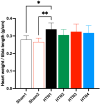Kalanchoe crenata Andrews (Haw.) Improves Losartan's Antihypertensive Activity
- PMID: 39770106
- PMCID: PMC11676209
- DOI: 10.3390/molecules29246010
Kalanchoe crenata Andrews (Haw.) Improves Losartan's Antihypertensive Activity
Abstract
Background: Cardiovascular diseases constitute one of the leading causes of morbidity and mortality worldwide. Herbal medicines represent viable alternatives to the synthetic drugs currently employed in the control of hypertension. This study aimed to isolate and identify the chemical markers of Kalanchoe crenata and to investigate the antihypertensive and anti-matrix metalloproteinase (MMP2) activities of an aqueous extract of the leaves.
Methods: The main constituents of the aqueous extract of K. crenata were separated by ultra-performance liquid chromatography-mass spectrometry, and their presence was identified by NMR spectroscopy. Renovascular hypertension was induced in male Wistar rats using the two-kidney one-clip method (HTN groups), while control animals (Sham groups) were submitted to Sham surgery. Six groups of 10 animals each were treated daily for eight weeks as follows: Sham 1 (carrier), Sham 2 (K. crenata extract), HTN.1 (carrier), HTN.2 (K. crenata extract), HTN 3 (losartan), and HTN 4 (K. crenata extract with losartan).
Results: The main compounds of the extract were patuletin 3-O-(4″-O-acetyl-α-L-rhamnopyranosyl)-7-O-(3‴-O-acetyl-α-L-rhamnopyranoside) (1), patuletin 3-O-α-L-rhamnopyranosyl-7-O-L-rhamnopyranoside (2), and trans-caffeoyl-malic acid (3), with compounds 1 and 2 being chemical markers of the species. Significant reductions (p < 0.05) in systolic blood pressure and MMP2 (72kDa isoform) activity were observed in the HTN 4 group.
Conclusions: The association of K. crenata extract and losartan presented in vivo effects against hypertension.
Keywords: hypertension; medicinal plant; murine model; patuletins; systolic blood pressure.
Conflict of interest statement
The authors declare that the research was conducted in the absence of any commercial or financial relationships that could be construed as a potential conflict of interest.
Figures





References
-
- Wang W., Hu M., Liu H., Zhang X., Li H., Zhou F., Liu Y.-M., Lei F., Qin J.-J., Zhao Y.-C., et al. Global Burden of Disease Study 2019 suggests that metabolic risk factors are the leading drivers of the burden of ischemic heart disease. Cell Metab. 2021;33:1943–1956.e2. doi: 10.1016/j.cmet.2021.08.005. - DOI - PubMed
-
- Dicker D., Nguyen G., Abate D., Abate K.H., Abay S.M., Abbafati C., Abbasi N., Abbastabar H., Abd-Allah F., Abdela J., et al. Global, regional, and national age-sex-specific mortality and life expectancy, 1950–2017: A systematic analysis for the Global Burden of Disease Study 2017. Lancet. 2018;392:1684–1735. doi: 10.1016/S0140-6736(18)31891-9. - DOI - PMC - PubMed
-
- WHO . The Global Health Observatory. Blood Pressure/Hypertension. WHO; Geneva, Switzerland: 2024.
MeSH terms
Substances
LinkOut - more resources
Full Text Sources
Medical
Miscellaneous

